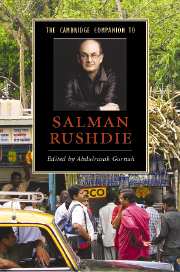Book contents
- Frontmatter
- 1 Introduction
- Part I: Themes and Issues
- Part II: Studies of Individual Texts
- 6 Tricksters and the common herd in Salman Rushdie’s Grimus
- 7 Themes and structures in Midnight’s Children
- 8 Reading ‘Pakistan’ in Salman Rushdie’s Shame
- 9 The Satanic Verses: ‘To be born again, first you have to die’
- 10 The shorter fiction
- 11 The politics of the palimpsest in The Moor’s Last Sigh
- 12 The Ground Beneath Her Feet and Fury: The reinvention of location
- Guide to further reading
- Index
- Series List
8 - Reading ‘Pakistan’ in Salman Rushdie’s Shame
from Part II: - Studies of Individual Texts
Published online by Cambridge University Press: 28 November 2007
- Frontmatter
- 1 Introduction
- Part I: Themes and Issues
- Part II: Studies of Individual Texts
- 6 Tricksters and the common herd in Salman Rushdie’s Grimus
- 7 Themes and structures in Midnight’s Children
- 8 Reading ‘Pakistan’ in Salman Rushdie’s Shame
- 9 The Satanic Verses: ‘To be born again, first you have to die’
- 10 The shorter fiction
- 11 The politics of the palimpsest in The Moor’s Last Sigh
- 12 The Ground Beneath Her Feet and Fury: The reinvention of location
- Guide to further reading
- Index
- Series List
Summary
The pressures of contemporary civilization and the flux of values lead to the forceful imposition of simplistic explanations, upon which befuddled men can base concerted courses of action, always with the end in view of getting out of the mess of modern day reality.
Our thoughts have bodies . . .
Salman Rushdie's Shame is as much a contemplation of the migrant artist as it is an engagement with the problems of narrating Pakistan - a nation superimposed upon an Indian geopolitical substrate and created-indivision, comprising a sizeable (im)migrant population created by Partition's displacement of 12 million people across South Asia (and the deaths of 1 million). If Shame speaks of the artist-figure - Omar Khayyam, who provides the model for the novel's peripheral hero, Omar Khayyam Shakil - with the consolatory sentiment that something can 'be gained' in the translations of the migrant (Shame, p.29), then the shifting nature of reading practices should permit us to indulge in similarly beneficial transports. In effect, Shame's, insistence upon the primacy of translation authorises the changeable character of our acts of interpretation. As Rushdie's fiction is keenly aware, translation always addresses at least two places, whether it involves a movement between a source language and a target language, or the migrant's movement across borders and cultures. As I hope to show, much of Shame's imaginative work consists in a doubleness of articulation that not only addresses post-Partition Pakistan and racism in Britain in the early 1980s, but may also enable literary criticism as a political act within its own place and time.
- Type
- Chapter
- Information
- The Cambridge Companion to Salman Rushdie , pp. 109 - 124Publisher: Cambridge University PressPrint publication year: 2007

